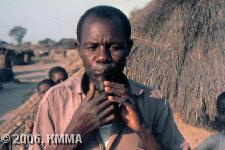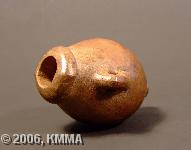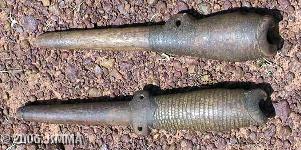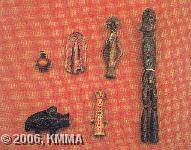



The majority of wind instruments from Africa in the KMMA organological collection are small signalling flutes or whistles.
These small flutes are used chiefly as signalling instruments, in hunting for example. A mouthpiece (blowhole) is cut on the upper side of the body, and on one or both sides, a sound hole is bored, making it possible to produce two or three tones. The same principle is applied in the slit-drum and is based on the tonal structure.
This instrument is notable for its wide variety and often ornate and artistic forms. In the KMMA, 1,465 examples of this instrument type are preserved, where the flutes that are most outstanding come from the Tshokwe because of their extremely beautiful sculptured form, often inspired by the mask worn during certain rituals.
These anthropomorphic decorations lend a special character to the instrument but other types (zoomorphic, barrel-shaped, phallic) are set equally apart by their artistry.
A type that holds a special place in the KMMA collections is the flute shaped like a European key as they used to be made. Just as, in times gone by, there was in our part of the world the game of blowing into the hollow tube of a key, the Pende imitated this European key in ivory and transformed it into a musical instrument.
Considering the attention paid to creating these signalling flutes in Central Africa, one can deduce that for many people the artistic presentation of the instrument is certainly as important as the musical purpose it serves. This instrument is principally intended for communication during hunting (the hunters signal their location to each other, signal the presence of game, or to which side the hunt should be directed, etc.), but it is not used exclusively for this purpose. In many tribes the flute is also played as an accompaniment in other musical styles, together with the other instruments in an ensemble.
The materials to make these flutes are both wood and ivory. Among some tribes, such as the Tshokwe, the same type of flute is crafted in both materials, while other tribes have a preference for either wood or ivory.
This type of instrument is used in recordings of our sound archives made with the Congolese peoples mentioned hereafter where it appears with the following vernacular names:
Kimbila (Mbambi) (Kongo), Lushiba (Luba), Mbambi (Kongo), Moutsiatsi (Bembe), Mumpelende (Luba), Museng (Lunda), Mwan'a kwei (Leele), Mwanzi (Zande), Ndond'lo (Leele), Ntcheem (Kuba), Onswom (Mputu), Pîtu (Kongo), Tsei (Pygmées), Tshimpololo (Sala Mpasu)
Bibliography:
Discography:
© KMMA